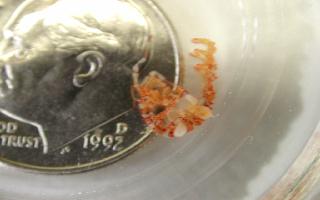Mayerella banksia (Laubitz, 1970)Common name: Skeleton Shrimp |
|
| Synonyms: None |  |
| Phylum Arthropoda
Subphylum Crustacea Class Malacostraca Subclass Peracarida Order Amphipoda Suborder Caprellidea Family Aeginellidae |
|
| Mayerella banksia collected at Rosario Bay among drift algae. | |
| Photo by: Christina Smith, June2002 | |
How to Distinguish from Similar Species: Amphipods within the suborder Caprellidea are all relatively similar, although they are easier to differentiate between than the rest of the amphipods. A dissecting microscope is necessary in order to tell the differences between Caprellidea.
Geographical Range: Temperate areas
Depth Range: Intertidal
Habitat: These amphipods are intertidal and commonly found among small algal clumps.
Biology/Natural
History:
These are among the most
bizarre and interesting amphipods. These elongate animals
bear clinging
feet at both the forward and the rear ends. Most of the body
consists
of elongate thoracic segments; the abdomen is much reduced.
These
animals have gills on the fourth and fifth pairs of thoracic segments
only.
They remind one of a praying mantis, partly because of their general
form
and partly because of the appearance of their prehensile first and
second
legs. It is interesting to watch their looping movements:
they attach
themselves by their more anterior legs as they let go with the legs
that
are in the rear portion of the body; then, after bringing the hind end
forward, they attach themselves by the rear legs again. They
may
remain motionless much of the time. Some of the caprellids
associated
with hydroids nip off the polyps and eat them; others feed mostly on
diatoms
and detritus.
| Return to: | |||
| Main Page | Alphabetic Index | Systematic Index | Glossary |
References:
Dichotomous Keys:
Kozloff (1987)
General References:
Morris
et al (1980)
Scientific Articles:
General Notes and Observations: Locations, abundances, unusual behaviors, etc.:
Authors and Editors of Page: Christina R. Smith
Christina Smith (2002): Created original page
Edited by Hans Helmstetler